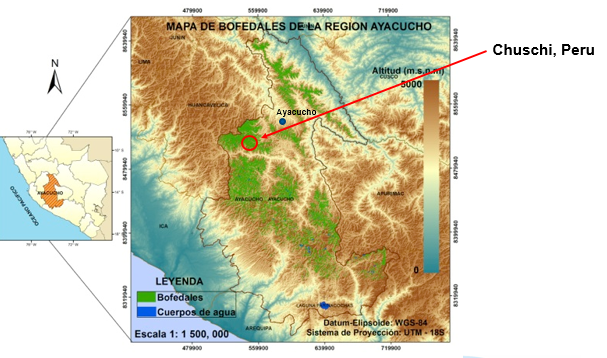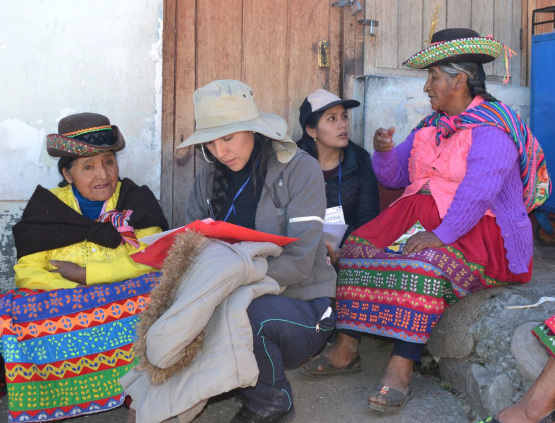 As part of a larger project being jointly developed by the International Water Security Network (IWSN) and the Centro de Competencias del Agua (CCA), the 12 questions underpinning the household water insecurity index developed by the HWISE Consortium were recently deployed in the Peruvian Andean community of Chuschi.
As part of a larger project being jointly developed by the International Water Security Network (IWSN) and the Centro de Competencias del Agua (CCA), the 12 questions underpinning the household water insecurity index developed by the HWISE Consortium were recently deployed in the Peruvian Andean community of Chuschi.
Funded by the Newton-Paulet Institutional Links programme, the project “Strengthening local capacities for the sustainable management of Andean headwater wetlands facing global change” aims to better understand the changing quantity and quality of water available for people and the environment in the middle and high Andes of Peru. This multidisciplinary project is particularly focussing on the Quechua-speaking community of Chuschi and its dependence on the water resources further up the Chiqllarazu catchment. At the top of the catchment, at approximately 4,100-4,400 m.a.s.l. (in the ‘puna’ region according to commonly accepted elevational zone models of the Andes), large wetlands provide significant water storage and treatment, as well as supporting significant flora and fauna. Long used for seasonal grazing of alpacas and for local water supply, these wetlands may offer significant extra water-related ecosystems services to mitigate high altitude water storage lost to glacial recession.
Brief background about Chuschi
Located in the western part of Ayacucho District and at an elevation of 3,200 m.a.s.l., it is populated by more than 700 comuneros and comuneras, most of whom raise alpaca, cattle and sheep. Community members actively use, according to a system of mixed transhumance and agriculture, three distinct micro-regions including:
- the ‘sallqa’ or ‘puna’, divided into two areas: one for livestock activity of alpacas, llamas, sheep and cows between 3,300 and 4,000 m.a.s.l.; and another where tubers and grains are grown between 3,300 and 3,600 m.a.s.l..
- the ‘qichwa’, where corn is produced below 3,300 meters and where the town of Chuschi is located; and
- the ‘mayopatan’, or riverbank, where some fruit trees and corn are grown at around 2,300 m.a.s.l..
With the land reform of 1969, large estates were expropriated on the coast and mountains of the country. Unlike other communities, Chuschi did not experience the hacienda model; the closest was located elsewhere in the province of Huamanga. Thus the grazing and cultivation systems have always been controlled by the villagers and, for a short period, by the local church.
Chuschi is also the place where the Shining Path Maoist insurgency first manifested itself violently and launched its armed war against the Peruvian state in 1980, as well as the site of the Chuschi Massacre by the Peruvian army in 1991. Before peace was restored in the 1990s, migration and the displacement of Chuschinas families intensified, leaving much land untended. Throughout Peru internal displacement affected about half a million people, mostly Quechua speakers, who found themselves in need of refuge in the cities. The consequences of displacement included the migration of the youngest members of families, the abandonment of grazing areas, and the reduction of the size of livestock holdings, at family and community scale, due to the risk of robbery or violence.
Findings to date and use of the HWISE Indicator
Whilst the project is still ongoing we can report a number of recent findings including:
- Many puna wetlands in the region seem to be in good or very good ecological condition. Quantitative and qualitative assessments of water resources suggest that there are sufficient water resources of acceptable quality for local needs and for more distant users further down the catchment, though in some sub-areas there are elevated levels of certain heavy metals, whose origin is still being studied.
- There is still much grazing going on in this region, with stocking densities relatively high. Impacts are still under study.
- Many local community leaders are aware of their rights and responsibilities with respect to water, though the Peruvian government’s flagship Mecanismos de Retribución por Servicios Ecosistémicos programme (a system similar to Payment for Ecosystems Services) remains relatively unknown.

administering the questionnaire in July 2019, Chuschi, Peru
As regards household scale water security, application of the key HWISE questions as part of a larger survey in July 2019 reveals that households in the community describe themselves as relatively water insecure (average HWISE score is 15.2, where a score above 12 indicates water insecurity). There was considerable variation in reported experience however, with a low score of 1 and a high score of 27. This is interesting because not only are water resources relatively abundant locally, but the Peruvian government has in recent years undertaken considerable work to bring piped water to local homes wherever they are located, usually through the creation of small decentralised surface water collection and distributions systems.
Implementation of the HWISE questions as part of our larger questionnaire survey proved quite tricky for the following reasons:
- Many respondents have more than one residence (modern forms of transhumance!) and frequently commented that the answers to the questions might be different if they were approached when they were at their other home. There is also a relationship between alternation of residence and annual alternation between wet and dry seasons.
- Some of the concepts in the HWISE survey were difficult to translate into Quechua. For example, distinctions between ‘rarely’ and ‘sometimes’ are not commonly made in Quechua, and affective terms like ‘shame’ were difficult to exactly translate in a way that was sympathetic to cultural sensitivities.
- The ‘random walk’ method described in the HWISE Guidance was unworkable in this community where it proved much more effective to join a community event to bring respondents together to participate in the research.
It was also a challenge that our survey about anthropogenic pressures on high Andean basins, of which HWISE was only a part, was perhaps a little long, often taking 30 minutes to complete.
Work to analyse the results obtained from the questionnaire survey, and from semi-structured interviews, is ongoing with a workshop planned for January 2020 in Bristol, UK.
